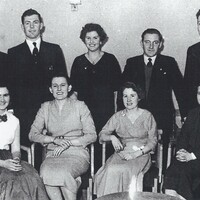 Cumann Éinde Gathering ~ 1959
Cumann Éinde Gathering ~ 1959 The picture shows a gathering of Cumann Éinde taken at Yann Studios, Galway. Among the Group is Prof. Frank Imbusch and Dr Tom O’Connor from the Department of Experimental Physics, University College Galway. Names are listed below:
Back row: (l-r) Frank Imbusch; Peter (?) Moylan; John P. O’ Callaghan; Róisín Mullaney; Eamon Lee; Tom O’Connor
Front row (l-r) Eileen Powell; Margaret Stewart; Eva McHugh; Mary Moylan; Carmel Fenton
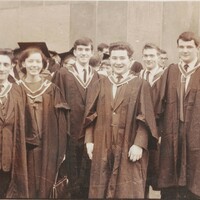 B.Sc. Graduates, 1965
B.Sc. Graduates, 1965 The photograph shows six Science graduates at the front of the picture, namely from left to right: Liam Kelleher (Experimental Physics); Catherine Woods (Experimental Physics); Stephen G. Jennings (Experimental Physics); Michael Hynes (Chemistry); Tony McDevitt (Experimental Physics); and Hilary Lawless (Chemistry). The B.Sc. degrees were conferred in the Aula Maxima by the then President of University College Galway, Martin J. Newell.
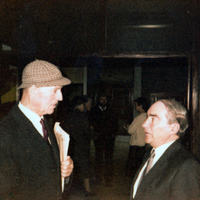 Tomás S. Ó Máille
Tomás S. Ó Máille Rugadh Tomás Seosamh (S.) Ó Máille i Hanley, Staffordshire, i Sasana, sa mbliain 1904. Chláraigh sé mar mhac léinn i gColáiste na hOllscoile, Gaillimh i mí Dheireadh Fómhair 1930. Bhain sé céim B.A. amach sa mbliain 1933. Ceapadh é ina Chúntóir lánaimseartha i Roinn na Gaeilge i gColáiste na hOllscoile, Gaillimh agus mar Léachtóir le Teangacha Ceilteacha i 1947. Bhí sé ina Ollamh le Nua-Ghaeilge ó 1953 go dtí gur éirigh sé as an bpost i 1974. Bronnadh DLittCelt air i 1971. D’éag sé ar 27 Lúnasa 1990 (www.ainm.ie/Bio).
Is é a dúirt Críostóir Túinléigh (iarleabharlannaí Ollscoil na hÉireann, Gaillimh) le Séamus Mac Mathúna, Rúnaí um Ghnóthaí Acadúla na hOllscoile, gurb amhlaidh go raibh ranganna Gaeilge á dtabhairt i Manchain ag an (sean) Ollamh Tomás Ó Máille, go raibh Tomás S. ag freastal orthu sin, agus gur spreag sean-Tomás é le dul go Gaillimh mar mhac léinn.
Sé Oilibhéar Ó hEidhin (ar thaobh na láimhe deise) an fear eile sa bpictiúir. Bhí sé ina phríomhoifigeach de Choiste Gairmoideachais na Gaillimhe.
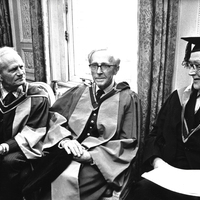 W. Hayes, D. Binchy and M. Duignan, 1973
W. Hayes, D. Binchy and M. Duignan, 1973 The National University of Ireland conferred an honorary Doctorate of Celtic Literature on the eminent Celtic scholar Professor Daniel Binchy in April 1973. The citation was read by Professor Michael Duignan .
The photograph shows, left to right, Dr William Hayes, Professor Daniel Binchy and Professor Michael Duignan. Dr Hayes, a renowned scientist in the field of bacterial genetics, was awarded a Doctorate of Science on the same occasion and the citation was read by Professor Colm Ó hEocha, then President of NUI Galway.
Text of the citation read by Professor Michael Duignan, NUI Galway, on the occasion of the conferring of an honorary doctorate on Professor William Binchy, 12 April 1973.
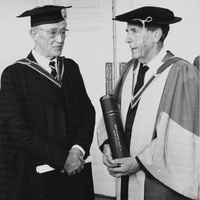 Conferring of Honorary Doctorate of Science on Professor George F. ('Frank') Mitchell, 31 March 1977
Conferring of Honorary Doctorate of Science on Professor George F. ('Frank') Mitchell, 31 March 1977 The National University of Ireland conferred an honorary Doctorate of Science on Professor George F. Mitchell in March 1977. The citation was read by Professor Michael Duignan The photograph shows Professor Mitchell on the right, Professor Michael Duignan on the left. Professor Mitchell was generally known as Frank Mitchell.
Citation delivered by Professor Michael Duignan at the conferring of a doctorate honoris causa on Professor George Francis Mitchell, 31 March 1977. Professor Mitchell, who held the chair of Quaternary Studies in Trinity College Dublin, was generally known as Frank Mitchell.
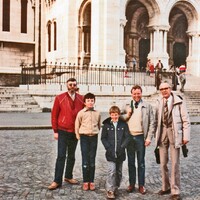 UCG Social Club outing to France in 1983
UCG Social Club outing to France in 1983 A University College Galway (UCG) Social Club outing was organised by Brendan Devlin who was kind of a "procurement officer" for the Buildings Office. The Social Club Group went to Paris and to Versailles in Easter of 1983. The picture shows from left to right: Hubert Mc Dermott, two of his family; Jim Houghton; and Billy O'Connor outside the Sacré-Coeur in Paris.
Hubert McDermott was Professor of English at UCG.
Jim Houghton was Professor of Microbiology & Cytogenetics at UCG.
Billy O'Connor worked in Accounts at UCG.
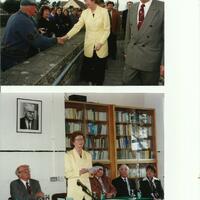 An tUachtarán Máire Mhic Róibín (President Mary Robinson) in Áras Mháirtín Uí Chadhain
An tUachtarán Máire Mhic Róibín (President Mary Robinson) in Áras Mháirtín Uí Chadhain Uachtarán na hÉireann, Máire Mhic Róibín, ar cuairt chuig Áras Mháirtín UÍ Chadhain, An Cheathrú Rua, Co. na Gaillimhe, i 1993 le comhdháil ar an aosoideachas sa Ghaeltacht a oscailt agus le hóráid a thabhairt. Ba é seo an chéad Ionad Ollscoile sa Ghaeltacht ag an gColáiste. /
President of Ireland, Mary Robinson, on a visit to Áras Mháirtín Uí Chadhain, An Cheathrú Rua, Co. Galway, in 1993 to open a conference on adult education in the Gaeltacht and to deliver an address. This was the College's first Ionad Ollscoile (University Centre) in the Gaeltacht.
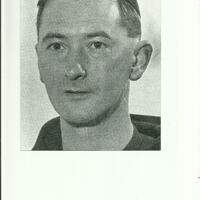 An tAthair Colmán Ó hUallacháin
An tAthair Colmán Ó hUallacháin An tAthair Colmán Ó hUallacháin (1922-79), a Franciscan priest, was a pioneering figure in linguistics in Ireland in the 1960s and 1970s. A UCG BA graduate in 1949 (as Liam M. Ua hUallacháin - Colmán was his name in religion), his early focus was Philosophy, completing his doctoral thesis in Louvain on the medieval Franciscan philosopher John Duns Scotus, and he lectured on Philosophy trí Ghaeilge here (1953-56) and published Foclóir Fealsaimh in introduced to Ireland the principles and methods of modern linguistics, and propagated their application to the teaching of Irish and other languages, and to the acquisition of language skills by native English-speakers (especially those with language-related disabilities). Appointed adviser on linguistics to the minister for education (c.1962), he catalysed the development in Gormanston college of a language centre, An Teanglann – one of the first of its kind in Ireland – and became its director (1964). The centre conducted research relevant to language teaching, and trained teachers in linguistic theory and audio-visual methodology. He initiated basic linguistic research in both spoken Irish and English as spoken in Ireland, involving analysis of questionnaires and of tape-recorded conversation, and constructed a ‘language minimum’ of vocabulary, morphology, and syntax necessary for effective communication within various age groups, thereby facilitating development of appropriate programmes of instruction based on the language as actually spoken. The research resulted in the launch of Buntús Gaeilge, a basic audio-visual course for primary schools (1966), and an RTÉ radio and television course in conversational Irish, ‘Buntús cainte’ (1967–8)
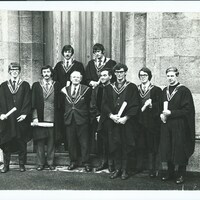 Physics Graduation Class of 1971
Physics Graduation Class of 1971 The picture shows the 1971 Honours Physics graduation class with names from left to right as follows:
Back row: John Sheil; Ted Hyland
Front row: John O’Dea; Liam Kelly; Cilian Ó Brolcháin; Frank Imbusch; Gerry O’Brien; Brian Leavy; Bro. Eamonn MacLochlainn
Prof. Cilian Ó Brolcháin was Head of the Dept. of Experimental Physics (1934-1973).
Dr Frank Imbusch was then Associate Prof. in the Dept. of Experimental Physics.
Cilian Ó Brolcháin obtained his BSc in UCD in 1925 and his MSc in 1926, after which he studied under Nobel prizewinner V.F. Hess in Graz. Following a period as lecturer in UCG in 1932, he was appointed to the Chair of Experimental Physics there in 1934, upon the retirement of Prof. Alexander Anderson. He served as Dean of Science and took a keen interest in the teaching of science and other disciplines through Irish. In 1973, ill health obliged Cilian Ó Brolcháin to retire and he passed away in Galway in 1976 (www.ainm.ie/Bio).
Frank Imbusch graduated in Physics at UCG in 1956 and obtained an M.Sc. also at UCG in 1958. He obtained his Ph.D. at Stanford, followed by some years in Bell Labs in New Jersey, before returning to a Lectureship in Experimental Physics at UCG in 1967. After becoming Associate Professor in 1970, he was appointed Prof. of Experimental Physics at UCG in 1974. He was Vice-President (Human and Physical Resources) 1992-98. He retired in 2001.
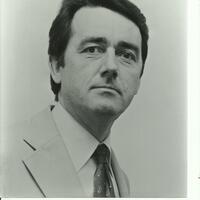 Dioraí Ó Coirbhin, Rúnaí-Sparánaí / Secretary-Bursar
Dioraí Ó Coirbhin, Rúnaí-Sparánaí / Secretary-Bursar This is a photograph of Dioraí Ó Coirbhin, Rúnaí-Sparánaí / Secretary-Bursar (1967-90). His appointment was the first step in the professionalisation of the Administration, in response to the unprecedented growth of the College in the 1960s. Till then, the senior administrative offices of Registrar, Secretary and Bursar had been part-time and held by fulltime Professors, but with the imminent retirement of the two incumbent Professors in the mid-1960s (Professor James Mitchell, Registrar and Secretary, and Professor Patrick Larkin, Bursar), the opportunity was taken to make those roles fulltime and to recruit two professional administrators (not at the same time Professors or Lecturers) to undertake them. The office of Bursar was made fulltime by Statute LXIII (1965) and Dioraí Ó Coirbhin was appointed thereto in 1967. Under Statute LXVIII (1967), the office of Secretary was combined with that of Bursar, without any extra remuneration, and the holder was thenceforth titled Rúnaí-Sparánaí /Secretary-Bursar. The restructuring of the office of Registrar was more complicated, as the Charter of the College required that there be a Registrar. Under Statute LXXVIII (1969), which established the new office of Academic Secretary to undertake the functions previously handled by the Registrar, new responsibilities relating mainly to new academic staff, academic staffing and resources, and student welfare were accordingly assigned to the Registrar (who was required to be a Professor elected for a three-year term, subject to a maximum of two terms). Séamus Ó Cathail was then appointed Academic Secretary / Rúnaí Acadúil, the second of those two senior professional administrators.
Dioraí Ó Coirbhin, BSc (Econ), FCA, a native of Belfast, graduated from Queen's University, Belfast, where he later was a Lecturer; he also acted as Extern Examiner for the NUI. In the qualifying examination for Chartered Accountants, he got first place in Ireland and the Arthur H. Muir Memorial Prize. He later spent a period developing the accountancy practice of his father Aodh, who was a major figure in the Irish-language movement and the GAA in the North from the time of the War of Independence. Dioraí himself as an undergraduate was active in the activities of An Comhchaidreamh (an organisation established to promote Irish in the Universities) and in Galway continued his commitment to the language: Irish was the working language of his own Office and of the Accounts Office, and he inspired many administrative staff to avail of refresher courses in the Gaeltacht and to value the College's language tradition as an important of Europe's cultural diversity. His commitment, and that of Séamus Ó Cathail, to that vision of Galway's role in the provision of University education through Irish, would later come to be realised in the establishment of Áras na Gaeilge and Acadamh na hOllscolaíochta Gaeilge. Likewise he played a vital part in the establishment of the annual Conference of Irish University Administrators, bringing 28 senior administrators of all the Universities in the island of Ireland together in Galway in 1971 for the first formal Conference, and he cultivated European links through involving the College regularly in the OECD Programme on Institutional Management in Higher Education (IMHE). His responsibilities included Human Resources, Student Services, Buildings and Industrial Liaison, as well as the finance function, whose administration, investment and longterm planning systems he modernised and put on a sound footing for the development opportunities ahead. He died on December 4, 1990, aged 57.
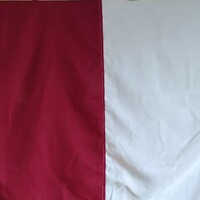 The College Flag
The College Flag The acquisition of a College Flag was authorised in 1919. Standing Committee, 16/06/1919: 'The Committee authorised Prof. Rishworth to order a College Flag, the colours to be maroon and white, no arms or emblems to be employed'.
On 26/03/1920, the Committee 'requested the Secretary to take charge of the College Flag. They decided (1) that it is to be used only in the College, and (2) that it is to be used only on the occasion of Inter-Collegiate matches, College or Inter-Collegiate Sports, and funerals of members of the College'.
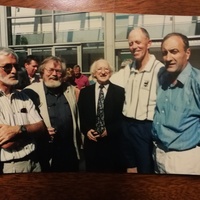 Outside Áras na Mac Léinn
Outside Áras na Mac Léinn Seen here in the foreground, in front of Áras na Mac Léinn, are (l.-r.) Séamus Grimes, Pádraig Ó Carra, Michael D. Higgins, Iognáid Ó Murchartaigh and Bernard (Brian) Finan. The man glimpsed between Séamus Grimes and Padraic Ó Carra is Eamon Cannon. The others present have not been identified.
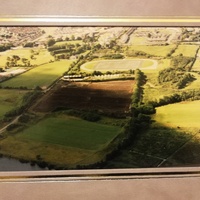 Aerial view of the north campus, 1989/90
Aerial view of the north campus, 1989/90 A view of the area by the Corrib River where new sports facilities were to be developed. This is now the site of the Sports Pavilion and playing fields. The buildings on the right are the nursery and maintenance yard used by buildings and grounds staff.
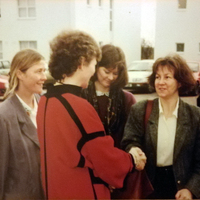 President Mary Robinson opens the Women's Studies Centre, 11 March 1991
President Mary Robinson opens the Women's Studies Centre, 11 March 1991 In March 1991, just over three months after her inauguration, President Mary Robinson visited NUI Galway to open the Women's Studies Centre (WSC) in a house in the recently built Corrib Village.
Seen here with President Robinson are (l.-r.): Anne Byrne, Elizabeth Tilley, Jane Conroy.
The WSC had been created in 1988. A seminar series was initiated that year and for several years an Interdisciplinary course in Women's Studies was provided for 1st-year Arts undergraduates. Until the time of President Robinson's visit the WSC had no designated office space. In 1992 the WSC began publication of the first women's studies journal in the country. The series continued until 2004. These volumes, being of importance for the history of gender studies in Ireland, have been made available online by the University of Galway Library. Atlantic Philanthropies generously funded Women's Studies in NUI Galway for several years.
A video recording of the entire event was made by Patsy Clancy, who heroically hand-held a camera in a crowded room for the duration (47 minutes). She had asked permission to make the video and it was granted. Afterwards she made a copy for herself, in case the original went missing. This is the copy that she put on You Tube in early 2024. It captures the excitement of the occasion, and the sense of a corner being turned that the participants all shared. The recording can be viewed via the link below.
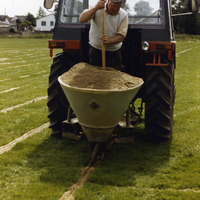 Remedial work on the playing fields, 1984-86
Remedial work on the playing fields, 1984-86 In the first photograph, John Connell from Menlo, one of the University grounds team, is seen working to improve the drainage of the Dangan sports fields. The second photograph shows Bernard Finan standing beside the tractor with John Connell on the left. A fuller view of the team involved is seen in photograph number three, while the fourth and fifth photographs show the early results of the work from different angles and at different stages.
In the mid 1980s the north campus playing fields, located in low-lying land near the River Corrib, were found to have drainage problems. A programme of work was undertaken to ensure that they could be used throughout the year. One method adopted was the creation of a network of intersecting slit trenches to eliminate surface water.
Since that time the Dangan Sports Campus has been developed to include two GAA pitches, two soccer pitches, a rugby pitch, a training pitch, a hockey pitch, an athletics track, tennis courts and a sports pavilion.
In the early days of the University managing the grounds was a much simpler task. The Calendar for 1897-1898 describes the outdoor amenities as follows: 'The Botanical Gardens, the cricket and football fields, the tennis and racquet courts are in the grounds surrounding the principal Building, as are also the Meteorological instruments, which are in charge of one of the College officers' (Calendar, p. 42).
The Galway campus now extends to 105 hectares along the River Corrib. The University also manages field stations in Finnavarra, and Carron in the Burren, and Carna in Connemara, all locations of exceptional importance for biodiversity.
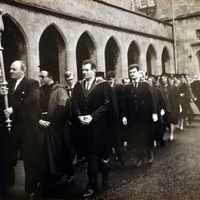 Carrying the mace, conferring ceremony, 1968
Carrying the mace, conferring ceremony, 1968 Pádraig Ó Fátharta, Head Porter, leads a procession of staff and recent graduates. Behind him, in the front row, are John Waddell, Professor Edmund Dougan and Joe McCabe. Towards the back, 3rd from the right, is Tom O'Connor.
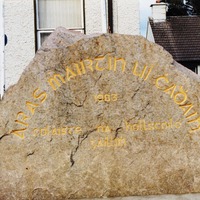 Áras Mháirtín Uí Chadhain - An Chloch Aitheantais
Áras Mháirtín Uí Chadhain - An Chloch Aitheantais An chloch aitheantais os comhair Áras Mháirtín Uí Chadhain, An Cheathrú Rua, a cuireadh ansin i 1983 nuair a ainmníodh an chéad Ionad Ollscoile Gaeltachta seo , a bunaíodh i lár na seachtóidí, ag an Ollscoil in ómós Mháirtín Uí Chadhain (1906-70), duine de mhórscríbhneoirí na Gaeilge, arbh as An Cnocán Glas, An Spidéal, dó . Ba í Gairmscoil na Ceathrún Rua a bhí sa bhfoirgneamh seo sula bhfuair an Ollscoil seilbh air chun na críche seo.
Ba é Máirtín Bán Breathnach as Leitir Mór na Coille, agus a raibh coiréal aige ar Bhóthar Ard Loch an Iolra , a thug an chloch éibhir bhreá seo saor in aisce don Ollscoil, agus ba é Jesus Modia a rinne an greanadh uirthi.
(The identification stone in front of Áras Mháirtín Uí Chadhain, An Cheathrú Rua, placed there in 1983 when the University's first Ionad Ollscoile Gaeltachta was named in honour of Máirtín Ó Cadhain (1906-70), one of the great Irish-language writers, a native of An Cnocán Glas, An Spidéal. This building was occupied by the Vocational School, Gairmscoil na Ceathrún Rua, before the University acquired it for this purpose.
This fine granite stone was gifted to the University by Máirtín Bán Breathnach from Leitir Mór na Coille, who had a quarry on Bóthar Ard Loch an Iolra. The engraving was done by Jesus Modia.)
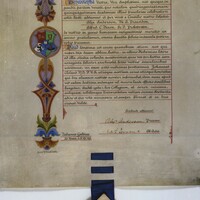 Illuminated address from QCG to University of Glasgow, 1901
Illuminated address from QCG to University of Glasgow, 1901 Illuminated Address from Queen's College, Galway to the University of Glasgow in 1901 in honour of its Ninth Jubilee, viz. the 450th anniversary of its foundation in 1451. The Address, entirely in Latin and bearing the arms of each institution in the left-hand margin with the Seal of QCG on a dark blue ribbon appended at the foot, bears the signatures of Alexander Anderson (President 1899-1934 and Professor of Physics 1885-1934) and Edward Townsend (Registrar 1880-1910 and Professor of Engineering 1860-1910). The document was produced by James McConnell, Dublin. It is a unique item in the University's Archives, as no copy (even black-and-white) of such actual Addresses has been preserved here, although the texts of various Addresses to royal visitors are recorded in the Minutebooks.
The origin of the Address lay in an invitation to the College from the University of Glasgow, as set out in the Minutes of a meeting of the Corporate Body (comprising the President and Professors, since the Charter of 12.10.1863; previously, under the Charters of 1845 and 1849, comprising the President, Vice-President and Professors) of the College on 16.03.1901: 'The President read a letter which he had received from the Chancellor, University Court, and Senate of the University of Glasgow inviting this College to send Delegates to the ninth Jubilee of the Glasgow University on the 12 June 1901. The President and Professor Dixon were appointed Delegates'. Professor Alfred Cardew Dixon was Professor of Mathematics (1893-1901).
The beautiful Latin text in Classical mode - for example, the greeting S.P.D. (Salutem Plurimam Dicit) at the outset - would presumably have been composed by Philip Sandford, Professor of Latin (1890-1903). The text is reproduced below under the 'Text in Image' heading, but the following literal translation gives the flavour:
QUEEN'S COLLEGE AMONG THE GALWEGIANS SENDS CORDIAL GREETINGS TO THE MOST ILLUSTRIOUS GLASGOW UNIVERSITY.
BY YOUR GOOD WILL, very distinguished men, we also, having been called to take our share of the joy with which you are about to celebrate the four hundred and fiftieth birthday of that famous Academy, are gladly present and through men chosen from our Council -
Alex. Anderson, M.A. President
Alfred C. Dixon, Sc.D. Professor -
we congratulate you from the heart on your most remarkable services to the human race, (and) pray for you everything auspicious and fortunate for the ages hereafter.
Not the most unimportant reason furthermore that we, who recently scarcely ten lustrums* ago in the farthest shore of Ireland approached the cultivation of those studies which you have already through ninety lustrums* successfully adorned, are present at your secular** festival days; for a man most accomplished in the art of medicine, John Cleland, M.D., F.R.S., dear to both of us and honoured by both, who taught our students diligently for a long time, the same man now discharges similar duties among you with the same learning and with the same or even greater praise. This College therefore dares, as a youngest sister, to approach your ancient and renowned University with the utmost respect and to proclaim its devout prayers that it flourish forever and grow day by day. Farewell.
At the writing were present
Alexr Anderson President
Edwd Townsend Registrar
We gave (i.e. wrote) at Galway
Ides*** of May 1901
James McConnell Dublin
* A lustrum was a five-year period
** The term ‘secular’ here refers to a period of over 100 years
*** 15 May
(Transcription and translation by Séamus Mac Mathúna)
The John Cleland highlighted in the text was Professor of Anatomy and Physiology in Queen's College, Galway from 1863 to 1877 before resigning to take up the Chair of Anatomy in the University of Glasgow.
 Foireann Oifig na Gaeilge Labhartha, 1991-2
Foireann Oifig na Gaeilge Labhartha, 1991-2 Foireann Oifig na Gaeilge Labhartha agus iad i mbun gnó le mac léinn. Mar is féidir a dhéanamh amach ón bhféilire, is i 1991-2 a glacadh an grianghraf.
(Staff of Oifig na Gaeilge Labhartha conducting business with a student. As can be determined from the calendar, the photograph was taken in 1991-2)
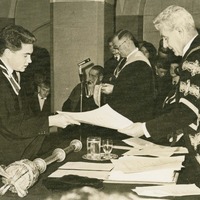 BA á bhronnadh ar Pheadar Mac an Iomaire, 1966
BA á bhronnadh ar Pheadar Mac an Iomaire, 1966 An chéim BA á bronnadh ar Pheadar Mac an Iomaire ag an Uachtarán, an Dr Máirtín S. Ó Tnúthail, i gcáil Sheach-Leas-Seansailéir Ollscoil na hÉireann, san Aula Maxima i bhFómhar 1966. Taobh leis, tá an tOllamh Michael V. Duignan (Deánach Dhámh na nDán) le hainmneacha na réamhchéimithe a léamh amach. Ar an mbord tá Más na hOllscoile agus hata oifigiúil an Uachtaráin. Tugann an t-íomhá léargas beoga ar shearmanas Bronnta na hama sin, agus na céimithe agus a ngaolta, lucht féachana agus baill den fhoireann acadúil ar mhullach a chéile sa spás beag sin.
Ceapadh Peadar Mac an Iomaire, MA, ATO, TTG sa phost nua, Stiúrthóir na Gaeilge Labhartha, i 1973 agus ansin ceapadh ina Phríomhfheidhmeannach ar Acadamh na hOllscolaíochta Gaeilge é i 2003. Chuaigh sé ar scor i 2009.
BA degree being conferred on Peadar Mac an Iomaire by the President, Dr Martin J. Newell, as Pro-Vice-Chancellor of the NUI, in the Aula Maxima in Autumn 1966. Professor Michael V. Duignan (Dean, Faculty of Arts) stands beside him to read out the list of graduands, On the table are the University Mace and the President's official hat. The image gives a vivid insight into a Conferring ceremony of that period, with the graduands and their relatives, spectators and members of academic staff packed together in that small space.
Peadar Mac an Iomaire, MA, ATO, TTG was appointed to the new post of Stiúrthóir na Gaeilge Labhartha in 1973 and then appointed Príomhfheidhmeannach of Acadamh na hOllscolaíochta Gaeilge in 2003. He retired in 2009.
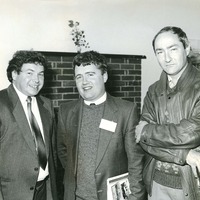 P. Mac an Iomaire, I. Mac Philip, M. Ó Briain
P. Mac an Iomaire, I. Mac Philip, M. Ó Briain Peadar Mac an Iomaire, Ivan Mac Philip (Léachtóir le Gnó agus Fiontar, GMIT) agus an Dr Máirtín Ó Briain (Léachtóir le Nua-Ghaeilge) ag caint.
Peadar Mac an Iomaire, Ivan Mac Philip (Lecturer in Business and Enterprise, GMIT) and Dr Máirtín Ó Briain (Léachtóir le Nua-Ghaeilge) conversing
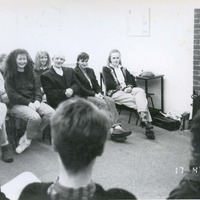 Oíche Sheanchais le Tom Pheaidí Mac Diarmada, 1990
Oíche Sheanchais le Tom Pheaidí Mac Diarmada, 1990 Tom Pheaidí Mac Diarmada (1909-2001), scéalaí, seanchaí agus file ón Lochán Beag, Cois Fharraige, le grúpa mac léinn le linn Oíche Sheanchais in Aibreán 1990 in Áras Mháirtín Uí Chadhain, An Cheathrú Rua.
Tom Pheaidí Mac Diarmada (1909-2001), storyteller, seanchaí and poet from An Lochán Beag, Cois Fharraige, with a group of students during an Oíche Sheanchais (a night of traditional storytelling) in April 1990 in Áras Mhairtín Uí Chadhain, An Cheathrú Rua.
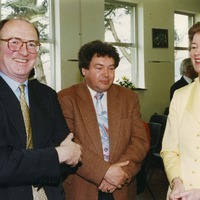 An tUachtarán Máire Mhic Róibín in Áras Mháirtín Uí Chadhain
An tUachtarán Máire Mhic Róibín in Áras Mháirtín Uí Chadhain Uachtarán na hÉireann, Máire Mhic Róibín, ar cuairt chuig Áras Mháirtín UÍ Chadhain, An Cheathrú Rua, Co. na Gaillimhe, i 1993 le comhdháil ar an aosoideachas sa Ghaeltacht a oscailt agus le hóráid a thabhairt. Ba é seo an chéad Ionad Ollscoile sa Ghaeltacht ag an gColáiste. Sa ghrianghraf seo tá Séamus Ó Grádaigh (Oifigeach an Aosoideachais) agus Peadar Mac an Iomaire (Stiúrthóir na Gaeilge Labhartha) ag caint leis an Uachtarán tar éis a léachta. Féach freisin íomhá 14524 ( 'An tUachtarán Máire Mhic Róibín (President Mary Robinson) in Áras Mháirtín Uí Chadhain' /
President of Ireland, Mary Robinson, on a visit to Áras Mháirtín Uí Chadhain, An Cheathrú Rua, Co. Galway, in 1993 to open a conference on adult education in the Gaeltacht and to deliver an address. This was the College's first Ionad Ollscoile (University Centre) in the Gaeltacht. This photograph shows Séamus O'Grady (Adult Education Officer) and Peadar Mac an Iomaire (Stiúrthóir na Gaeilge Labhartha) talking with the President after her lecture. See also image 14524 ('An tUachtarán Máire Mhic Róibín (President Mary Robinson) in Áras Mháirtín Uí Chadhain').